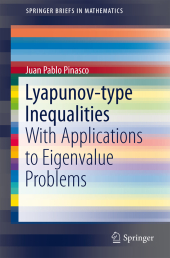 Neuerscheinungen 2013Stand: 2020-01-07 |
Schnellsuche
ISBN/Stichwort/Autor
|
Herderstraße 10
10625 Berlin
Tel.: 030 315 714 16
Fax 030 315 714 14
info@buchspektrum.de |

Juan Pablo Pinasco
Lyapunov-type Inequalities
With Applications to Eigenvalue Problems
2013. xiii, 131 S. XIII, 131 p. 235 mm
Verlag/Jahr: SPRINGER, BERLIN; SPRINGER NEW YORK 2013
ISBN: 1-461-48522-3 (1461485223)
Neue ISBN: 978-1-461-48522-3 (9781461485223)
Preis und Lieferzeit: Bitte klicken
The eigenvalue problems for quasilinear and nonlinear operators present many differences with the linear case, and a Lyapunov inequality for quasilinear resonant systems showed the existence of eigenvalue asymptotics driven by the coupling of the equations instead of the order of the equations. For p=2, the coupling and the order of the equations are the same, so this cannot happen in linear problems. Another striking difference between linear and quasilinear second order differential operators is the existence of Lyapunov-type inequalities in R^n when pn. Since the linear case corresponds to p=2, for the usual Laplacian there exists a Lyapunov inequality only for one-dimensional problems. For linear higher order problems, several Lyapunov-type inequalities were found by Egorov and Kondratiev and collected in On spectral theory of elliptic operators, Birkhauser Basel 1996. However, there exists an interesting interplay between the dimension of the underlying space, the order of the differential operator, the Sobolev space where the operator is defined, and the norm of the weight appearing in the inequality which is not fully developed. Also, the Lyapunov inequality for differential equations in Orlicz spaces can be used to develop an oscillation theory, bypassing the classical sturmian theory which is not known yet for those equations. For more general operators, like the p(x) laplacian, the possibility of existence of Lyapunov-type inequalities remains unexplored.
A short history of Lyapunov inequality.- Lyapunov inequality for p-laplacian operators.- Generalizations.- Lyapunov type inequalities in RN.
From the book reviews:
"This book presents in about 114 pages a good concise summary and a fairly comprehensive study of Lyapunov-type inequalities. ... The presentation is clear and well prepared as a whole. The book will be useful for a graduate or even an advanced undergraduate course where Lyapunov-type inequalities are studied or needed and for mathematicians working in the field." (Shao Zhu Chen, Mathematical Reviews, October, 2014)
"In this volume, the author presents in detail some of these aspects, from its origin to its current situation. ... The book contains many explanatory remarks and many comments on the cited bibliography, which can contribute to a better understanding of the theoretical results. Finally, this volume can be useful for researchers interested in the subject and also for all those who want to start in the field." (Antonio Ca¤ada Villar, zbMATH, Vol. 1291, 2014)


